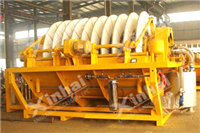Ceramic Filter

Product Introduction
A vacuum dewatering filter relying on microporous ceramic
Filtering Area
1~150m2
Product Improvement
Microporous ceramic as filtering medium saves cost by 90%
♦ Advantages
High vacuum degree (vacuum degree -0.09~-0.098MPa), low moisture of cake High filtration precision, solid content of filtrate<50ppm, which can be recycle used in the system.Energy saving up to 90%, low energy consumption, low running cost Filter cake cleaning system is installedPLC and computer integrate with automatic valve control; high degree of automation and low labor intensityCompact structure; small area taken; convenient maintenanceAdvanced drainage system ensures application in any running conditions
♦ Work Principle
Pulp absorbing area: filter plate immersed in the pulp while in operation produces a surface absorption of filter cake, with the action of capillarity and integrated with vacuum pressure. Filtrate enters distributing valve and drainage tank through filter plate.
Spraying zone: filter cake receive spray washing after discharged from the slime hopper
Drying zone: continuous dewatering for filter cake is conducted with the action of high vacuum force.
Discharging zone: scraper will automatically discharge materials once entering the vacuum-free condition
Back Flushing: Service water or filtrate enters the ceramic plate through distributing valve and cleaning the blocked manhole. Cleaning with ultrasonic and low density acid after ceramic plate is used for one period to maintain the efficient service life of ceramic plate.
♦ Product Structure
Ceramic filter is mainly composed of roller system, stirring system, feeding& discharge system, vacuum system, filtrate discharge system, scraping system, washing system, combined cleaning (ultrasonic cleaning, automatic mixing acid cleaning) system, automatic control system, tank body and frames.
It can be widely used in concentrate and tailings dewatering of mining non-ferrous metals, rare metals, ferrous metal, and nonmetals. Dewatering of oxide, electrolytic slag, leaching residue, slag in chemical industry, sewage and mud disposal engineering and so on. The particle size of the materials can be realized from -200 to -450 meshes.
| Ore Types | Particle Diameter Distribution | Feeding Concentration | Capacity kg.(m2h)-1 | Water Content of Filter Cake% |
|---|---|---|---|---|
| Gold concentrate | -200~-325 mesh | 50~60 | 900~1500 | 6.5~11.5 |
| Gold tailings | -200~-400 mesh | 45~60 | 400~600 | 13~16 |
| Copper concentrate | -200~-325 mesh | 45~60 | 600~900 | 6.5~12 |
| Iron concentrate | -200~-325 mesh | 40~60 | 850~1500 | 6~10 |
| Zinc concentrate | -200~-325 mesh | 50~60 | 750~900 | 6.5~12 |
| Lead concentrate | -200~-400 mesh | 50~65 | 650~800 | 10~12 |
| Bauxite | -200~-325 mesh | 50~60 | 350~450 | 10.5~12 |
| Lead and zinc tailings | -200~-325 mesh | 50~65 | 350~550 | 12~16 |
| Cyanide residue | -325~-450 mesh | 50~60 | 350~550 | 21~24 |
| Sulfur concentrate | -200 mesh 80% | 50~65 | 350~790 | 8~12 |
| Nickel concentrate | -200~-325 mesh | 55~60 | 300~600 | 10~12 |
| Coal concentrate | -200 mesh 80% | 50~65 | 550~930 | 18~20 |
| Zinc oxide | -200 mesh 75% | 55~65 | 620~1200 | 8~12 |
| Fluorite powder | -200 mesh 60% | 55~65 | 750~900 | 8~12 |
Products Detailed Parameters>>





